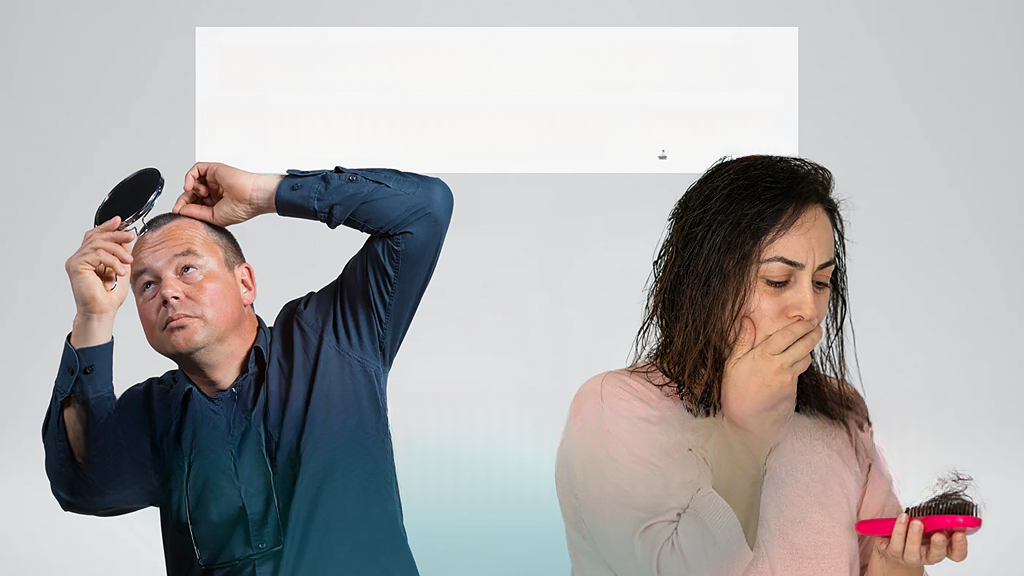
What Sets Hair Loss In Men and Women Apart? Let's Find Out
|
Don't leave yet. We have a special offer for you!
|
Did you know that 80% of men will experience hair loss by the age of 50, while 40% of women will experience hair thinning/loss in their lifetime?
Hair loss is a common concern affecting both men and women, though the patterns and causes can differ significantly between genders. For men, hair loss often follows a predictable pattern known as male-pattern baldness, characterized by a receding hairline and thinning at the crown, largely influenced by genetics and hormones like dihydrotestosterone (DHT). In contrast, women typically experience diffuse thinning across the scalp, known as female-pattern hair loss, which is more likely to be influenced by a combination of genetic factors and hormonal changes, particularly during menopause.
The emotional impact of hair loss is profound for both sexes, often leading to decreased self-esteem and increased stress. Studies have shown that approximately 50 million men and 30 million women in the United States alone experience significant hair loss. Despite these differences, the psychological effects are remarkably similar, with both men and women reporting feelings of embarrassment, frustration, and social withdrawal.
Understanding the underlying causes of hair loss is crucial in addressing this issue. Hormonal imbalances, genetic predispositions, and aging are key factors. Additionally, external factors such as stress, nutritional deficiencies, and certain medical conditions can exacerbate hair loss. By exploring these causes, we can better understand the why’s and how’s of hair loss, paving the way for more effective treatments and preventative measures tailored to both men and women.
The most common form of hair loss in men, typically presents as a receding hairline, temples, and thinning of hair in the crown. As this progresses, the balding patterns meet in the middle resulting in complete hair loss.
Unlike men who have a specific balding pattern, women who experience androgenic alopecia present in a diffuse pattern. This is seen as a sparse hairline, decreasing volume, and temple hair thinning. Interestingly enough, women rarely respond to the words “hair loss” but instead will respond to terms like ‘hair thinning’ or a ‘loss of volume’.
Fascinating Fact: Hair loss often goes unnoticed until around 50% of hair is lost. So if you're spotting thinning or a bald area, chances are more than half the hair is already gone in that spot.
Women, on the other hand, have less DHT hair loss and instead have menopause-related hair loss. As women age, they experience hormonal fluctuations, specifically a decrease in progesterone and estrogen which results in hair shedding, a change in the thickness, and quality of hair. A decrease in progesterone and estrogen also sparks an increase in androgens. These are male hormones that can be found in small amounts in women, rather than larger amounts in men. Androgens can cause the hair follicles on the head to shrink, resulting in a type of hair loss known as androgenic alopecia.
The primary reason for hair loss in men and women is hormonal or more specifically, androgenic, which is why hair loss is also called ANDROGENIC Alopecia. It shows up in men earlier due to high testosterone and high DHT, then later in women due to the decrease of estrogen and the increase of androgens.
Other factors for hair loss in men and women such as lifestyle choices, severe hairstyles, chemical processing, nutrition, stress, illnesses, and pollution can contribute to hair loss in men and women. The effects of different hairstyles and chemical treatments on hair can vary significantly based on the type of style or treatment, how often they are used, and an individual's hair characteristics.
For instance, protective styles like braids and twists can help prevent breakage and promote hair growth, but if done too tightly or left in for an extended period, they can cause tension leading to potential breakage and hair loss. Tight ponytails and updos can stress the hair shaft and scalp, resulting in breakage.
Frequent use of heated styling tools, such as hairdryers, straighteners, and curling irons, can lead to significant hair damage. These tools cause dryness and split ends by stripping the hair of its natural moisture, weakening its overall structure. Additionally, chemical processes like hair coloring, perming, relaxing, and keratin treatments can alter hair texture and appearance. While these treatments can enhance the look of your hair, they also pose risks if not applied carefully or used excessively. Potential damage includes severe dryness, breakage, scalp irritation, and even hair thinning.
To mitigate these adverse effects and maintain healthy hair, it is crucial to understand your hair type and adopt a hair care routine tailored to your specific needs. For instance, those with fine hair may require different care strategies compared to individuals with thick, curly hair. Incorporating moisture-rich shampoos and conditioners, limiting the use of heat styling tools, and opting for gentler, less frequent chemical treatments can help preserve hair health. Regular trims to remove split ends and using protective products can also prevent further damage. By being mindful of these practices, you can maintain the integrity of your hair, ensuring it remains strong, vibrant, and resilient against potential damage from styling and chemical treatments.




